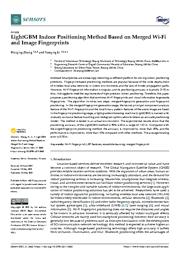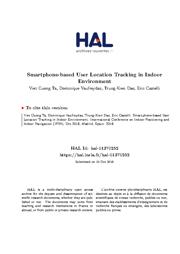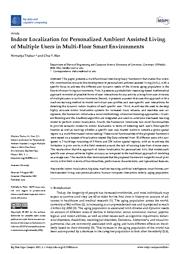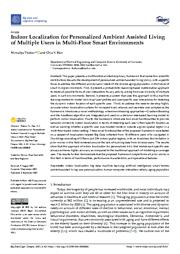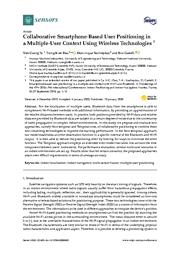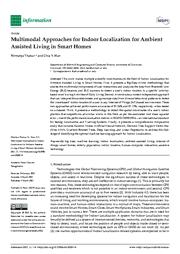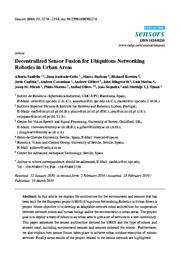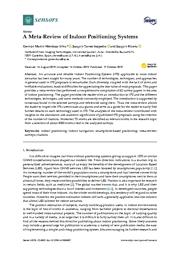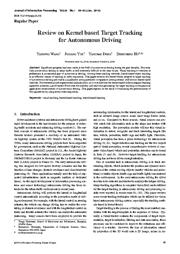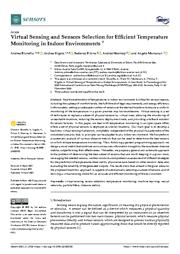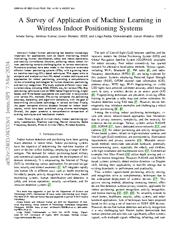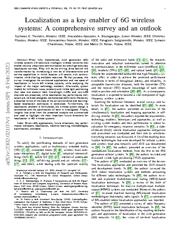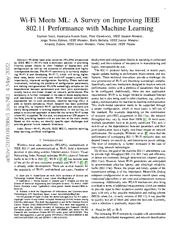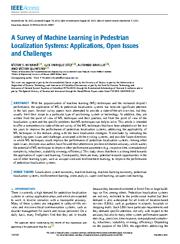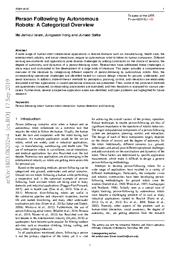A copy of this work was available on the public web and has been preserved in the Wayback Machine. The capture dates from 2021; you can also visit the original URL.
The file type is application/pdf.
Filters
LightGBM Indoor Positioning Method Based on Merged Wi-Fi and Image Fingerprints
2021
Sensors
Fingerprint-based positioning methods are popular because of the wide deployment of wireless local area networks in indoor environments and the lack of model propagation paths. ...
In the fingerprint positioning stage, a light gradient boosting machine (LightGBM) is trained with mutually exclusive feature bundling and histogram optimization to obtain an accurate positioning model ...
[35] discussed a merge strategy based on WLAN and images, using the extended naive Bayes method and a speeded-up robust features algorithm based on a hierarchical vocabulary tree to localize the WLAN ...
doi:10.3390/s21113662
pmid:34070259
fatcat:u3fjltnlpndzhljpjuox5dnuce
Smartphone-based user location tracking in indoor environment
2016
2016 International Conference on Indoor Positioning and Indoor Navigation (IPIN)
By testing on the provided training data, we have a good accuracy on building and floor identification. ...
This paper introduces our work in the framework of Track 3 of the IPIN 2016 Indoor Localization Competition, which addresses the smartphone-based tracking problem in an offline manner. ...
For solving this, we apply a particle filter. The moving model bases on the inertial data, which are accelerometer, magnetic and gyroscope sensors. ...
doi:10.1109/ipin.2016.7743704
dblp:conf/ipin/TaVDC16
fatcat:zgsrfh4tuvfv3jugruwrvsgqvm
Indoor Localization for Personalized Ambient Assisted Living of Multiple Users in Multi-Floor Smart Environments
[article]
2022
arXiv
pre-print
approaches Gradient Boosting and the AdaBoost algorithm are integrated and used on a decision tree-based learning model to perform indoor localization. ...
Second, it presents a system that uses this approach with a machine learning method to model individual user profiles and user-specific user interactions for detecting the dynamic indoor location of each ...
Acknowledgments: The authors would like to thank Isabella Hall, Department of Electrical Engineering and Computer Science at the University of Cincinnati for her assistance in formatting and presentation ...
arXiv:2207.09025v1
fatcat:cmr4velme5f5llzoc5dep4i6da
Indoor Localization for Personalized Ambient Assisted Living of Multiple Users in Multi-Floor Smart Environments
2021
Big Data and Cognitive Computing
approaches—Gradient Boosting and the AdaBoost algorithm are integrated and used on a decision tree-based learning model to perform indoor localization. ...
Second, it presents a system that uses this approach with a machine learning method to model individual user-profiles and user-specific user interactions for detecting the dynamic indoor location of each ...
[52] involved using particle filters and WLAN approaches to track the location information of the user in terms of spatial coordinates. The system had an RMSE of 4.3 m. Klingbeil et al. ...
doi:10.3390/bdcc5030042
fatcat:uqjl2zezqnfhbdloska7g53raq
Collaborative Smartphone-Based User Positioning in a Multiple-User Context Using Wireless Technologies
2020
Sensors
In this study, we propose and evaluate two approaches, namely Non-temporal and Temporal ones, of collaborative positioning to combine these two cohabiting technologies to improve the tracking performance ...
In practice, both positions provided by Wi-Fi data and relative distance provided by Bluetooth data are subject to a certain degree of noise due to the uncertainty of radio propagation in complex indoor ...
Extreme Gradient Boost Model Extreme Gradient Boost (XGB) model is also a tree-based learning method. The training process includes several rounds. ...
doi:10.3390/s20020405
pmid:31936878
pmcid:PMC7014462
fatcat:niisv6yp65d4lijd3fvce5276a
Multimodal Approaches for Indoor Localization for Ambient Assisted Living in Smart Homes
2021
Information
Finally, it presents a comprehensive comparative study that includes Random Forest, Artificial Neural Network, Decision Tree, Support Vector Machine, k-NN, Gradient Boosted Trees, Deep Learning, and Linear ...
Third, it presents a methodology to detect the spatial coordinates of a user's indoor position that outperforms all similar works in this field, as per the associated root mean squared error—one of the ...
This data can be found at: https://doi.org/10.17632/sy3kcttdtx.1 and https://www.kaggle.com/liwste/indoor-positioning, accessed on 13 February 2021. ...
doi:10.3390/info12030114
fatcat:ankfyi77inhqxg22fra3rcgzxq
Decentralized Sensor Fusion for Ubiquitous Networking Robotics in Urban Areas
2010
Sensors
This paper addresses the sensor architecture devised for URUS and the type of robots and sensors used, including environment sensors and sensors onboard the robots. ...
is to develop an adaptable network robot architecture for cooperation between network robots and human beings and/or the environment in urban areas. ...
PAU, Perception and Action under Uncertainty (DPI2008-06022) of the DPI program; and MIPRCV, Multimodal Interaction in Pattern Recognition and Computer Vision of the Consolider Ingenio 2010 program (CSD2007 ...
doi:10.3390/s100302274
pmid:22294927
pmcid:PMC3264480
fatcat:loivqbx5prbspeldiei6p2i6yi
A Meta-Review of Indoor Positioning Systems
2019
Sensors
An accurate and reliable Indoor Positioning System (IPS) applicable to most indoor scenarios has been sought for many years. ...
The paper provides the reader with an introduction to IPS and the different technologies, techniques, and some methods commonly employed. ...
The paper also compiled the most-recognized challenges in indoor positioning and deepens into positioning based on WiFi and BLE fingerprinting, which is the most popular method for indoor positioning. ...
doi:10.3390/s19204507
pmid:31627331
pmcid:PMC6832486
fatcat:nin6dirgcjbernymhx6dz4thqy
Review on Kernel based Target Tracking for Autonomous Driving
2016
Journal of Information Processing
This paper reviews the kernel theory adopted in target tracking of autonomous driving and makes a qualitative and quantitative comparison among several well-known kernel based methods. ...
Among these tracking methods, kernel-based object tracking is an effective means of tracking in video sequences. ...
Struck and On-line Boosting are the kind of tracking by detection method respectively based on SVM and boosting. ...
doi:10.2197/ipsjjip.24.49
fatcat:yvyqgiug6nclzdn5jqailxmm7i
Virtual Sensing and Sensors Selection for Efficient Temperature Monitoring in Indoor Environments
2021
Sensors
We first perform a systematic analysis of various distance metrics that can be used to determine the best sensors on which to base temperature monitoring. ...
Leveraging the selected sensors, we then conduct a comprehensive assessment of different strategies for the prediction of temperatures observed by physical sensors based on other sensors' data, also evaluating ...
Horn, and C. Mayer from Silicon Austria Labs GmBH for the helpful discussions and support.
Conflicts of Interest: The authors declare no conflict of interest. ...
doi:10.3390/s21082728
pmid:33924423
fatcat:q57eefxvaffcxgxyysczoysyxe
A Survey of Application of Machine Learning in Wireless Indoor Positioning Systems
[article]
2024
arXiv
pre-print
Key positioning techniques such as RSSI-based fingerprinting, Angle-based, and Time-based approaches are examined in conjunction with various ML methods. ...
Numerous attempts have been made in the literature to develop efficient indoor positioning systems (IPSs), with a growing focus on machine learning (ML) based techniques. ...
Addressing the complexity of indoor settings, [208] describes an explainable indoor localization (EIL) technique employing BLE's RSSI with a gradient boosting machine. ...
arXiv:2403.04333v1
fatcat:w5kzlryejza3bkb6z2dxbgpgve
Localization as a key enabler of 6G wireless systems: A comprehensive survey and an outlook
[article]
2023
arXiv
pre-print
Moreover, a detailed review of the state of the art conventional and learning-based localization techniques is conducted. ...
Afterwards, system models for millimeter wave, terahertz and visible light positioning that take into account both line-of-sight (LOS) and non-LOS channels are presented, while localization key performance ...
In [54] , the authors focused on the identification of key enabling technologies and applications of localization in the sixth generation (6G) networks. In [55] , the vision of cm-level localization ...
arXiv:2302.02107v1
fatcat:o2dcw6mrybbntfaaowhw7zv374
Wi-Fi Meets ML: A Survey on Improving IEEE 802.11 Performance with Machine Learning
[article]
2022
arXiv
pre-print
Based on this review, we identify specific open challenges and provide general future research directions. ...
Wireless local area networks (WLANs) empowered by IEEE 802.11 (Wi-Fi) hold a dominant position in providing Internet access thanks to their freedom of deployment and configuration as well as the existence ...
selection in industrial settings Higher throughput, lower delay than SOA method [67] RL particle filter 2020 S Select transmission rate Apply RL for 802.11ax rate selection Higher throughput, lower delay ...
arXiv:2109.04786v3
fatcat:ny55qfhsnfduzcxyve5mylpr2m
A Survey of Machine Learning in Pedestrian Localization Systems: Applications, Open Issues and Challenges
2021
IEEE Access
Among other open issues, most previous authors have focused their attention on position estimation accuracy, which wastes the potential of ML techniques to improve other performance parameters (e.g., response ...
Several survey papers have attempted to provide a state-of-the-art overview, but they usually limit their scope to a particular type of positioning system or technology. ...
The authors define a policy for moving direction, such that the localization accuracy improves by 72% in comparison to localization systems based on WiFi and particle filter (PF). ...
doi:10.1109/access.2021.3108073
fatcat:uw2jvwrka5ezncwhmybonke53i
Person Following by Autonomous Robots: A Categorical Overview
[article]
2019
arXiv
pre-print
Also, the corresponding operational challenges are identified based on various design choices for ground, underwater, and aerial scenarios. ...
Different working environments and applications pose diverse challenges by adding constraints on the choice of sensors, the degree of autonomy, and dynamics of a person-following robot. ...
The authors are with the Interactive Robotics and Vision Laboratory (IRVLab), University of Minnesota, Twin Cities, MN, USA. ...
arXiv:1803.08202v4
fatcat:wrqjbueulramzknpae3kt45kte
« Previous
Showing results 1 — 15 out of 96 results

